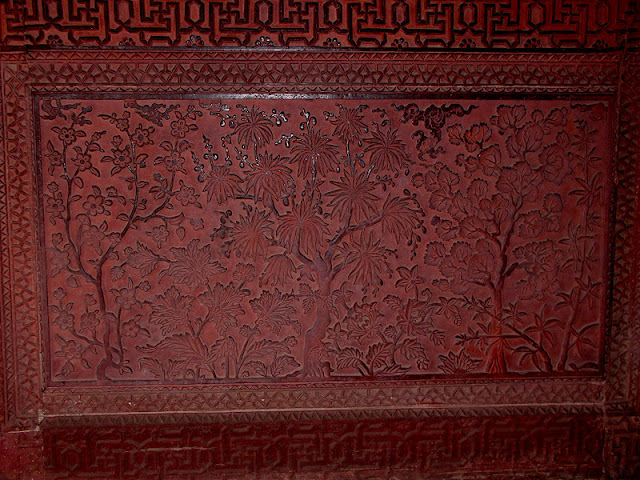The majority of the important monuments are found to the north of the road from Gaza to Agra; constructed of red sandstone, they form a homogeneous group, even if the eclecticism of their style is evident and is based on borrowings from Hindu, Persian and Indo-Muslim traditions.
Among the numerous palaces, gazebos, pavilions, etc., the following most noteworthy may be cited in particular:
Diwan-i-Am, the Hall of Public Audience, is encircled by a series of porticos which are broken up by the insertion of the imperial box where Akbar, surrounded by his ministers and officers meted out justice.
This box communicates directly with Daulat Khana (Imperial Palace), flanked to the north by Diwan-i-Kas (Hall of Private Audience), called the 'Jewel House', a monument known for its central plan, which comprises an extraordinary capital surmounted by a circular balcony: the 'throne'.
Other monuments of exceptional quality are the Ranch Mahal, whose elevation of four recessed storeys recalls certain Buddhist temples, the pavilion of Anup Talao, or the Turkish Sultana, the palace of Jodh Bai, the palace of Birbal, the caravanserai and the problematic 'stables'.
Owing to the piety of Akbar, many religious and votive monuments were constructed at Fatehpur Sikri. The great mosque (Jama Masjid), one of the most spacious in India (165 m by 133 m) could accommodate some 10,000 faithful; it was completed in 1571-72 and according to the dedicatory inscription deserves no less respect than Mecca. It incorporates, in the centre of the court, the tomb of Shaikh Salim, an extraordinary Christian masterpiece of sculpted decoration, further embellished under the reign of Jahangir.
To the south of the court, the Buland Damaza, completed in 1575, commemorating the victories (the taking of Gujarat in 1572) to which the city, their monumental symbol, owes its existence and its name.
This post is part of the Our World Tuesday meme,
and also part of the Ruby Tuesday meme.















A grand place! Very well captured.
ReplyDeleteBeautiful shots of magnificent place.
ReplyDeleteBeautiful shots. Love the composition of that first one.
ReplyDeleteJust gorgeous!
ReplyDeleteRuby Leaves is one of my entries. Please come and see, your comment will be very much appreciated.
This place is fantastic:)
ReplyDeleteBeautiful! Are this building made of clay or cement. So pretty!
ReplyDeleteKim,USA
Spectacular perspectives of this grand place! So love the intricate detail! And love the touch of colour from the women's saris wandering their!
ReplyDeleteSuch a beautiful share..
ReplyDeleteVisiting from Ruby Tuesday 2- hope you can stop by..
http://dsahmblogs.com/2012/09/tcp-zip-up-sherpa-hoodie.html